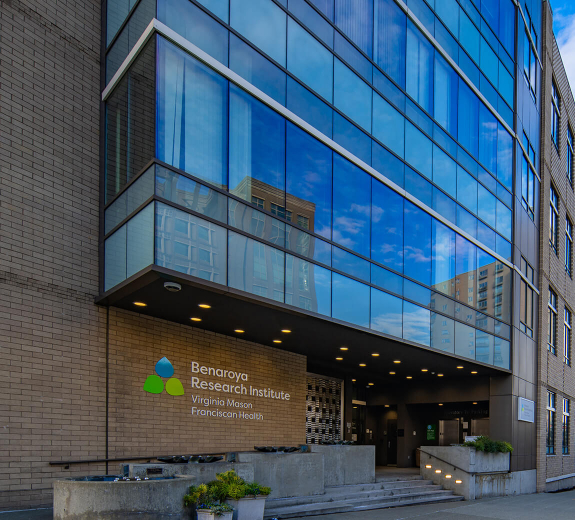BRI Receives $2.4 Million from National Institutes of Health
Benaroya Research Institute at Virginia Mason (BRI) received a new $2.4 million grant from the National Institutes of Health to develop tissue-engineered replacements for blood vessels that have been damaged or lost through disease or injury. Principal investigators for the grant are Robert B. Vernon, PhD, and Thomas N. Wight, PhD, of the Hope Heart Matrix Biology Program at BRI.
More than 4 million people in the U.S. are affected by arterial disease, with approximately 600,000 having bypass procedures each year to restore blood flow to their major organs or limbs. In general, the patient’s own blood vessels are the "gold standard" for replacement of diseased arteries. However, a substantial number of patients lack suitable blood vessels for grafting, and there is a need for alternatives. There is also a need to provide vascular shunts for dialysis patients and replacements for blood vessels damaged or lost by trauma. Replacements for blood vessels have been made from synthetic materials, but they have not yet proven to be completely satisfactory.
As an alternative to synthetic blood vessels, BRI is developing biologically based blood vessel replacements made from living cells seeded into prefabricated supports (scaffolds). To promote healing of the vascular graft, the scaffolds are made from structural molecules found in natural connective tissues. These tissue-engineered blood vessels, which ultimately would incorporate the patient’s own cells to limit rejection, may be the best approach to generate vascular grafts that function in all respects like natural blood vessels.
The new grant at BRI funds progress toward two key goals of vascular engineering. The first goal is to make engineered blood vessels that contain the protein elastin, a rubber-like molecule found in natural blood vessels that provides resilience and controls cell growth in the wall of the vessel. In natural blood vessels, elastin is made by smooth muscle cells in the vessel wall, but smooth muscle cells from adults (such as the patient’s own cells) produce little or no elastin. However, a major discovery at BRI by the Wight Laboratory found that the molecule versican 3 (V3), found in natural connective tissue, can induce adult vascular smooth muscle cells to produce and assemble elastin. The Wight Laboratory is developing new methods to produce V3 in a purified form, which will be tested for its ability to induce elastin production in engineered vessels containing vascular smooth muscle cells from adult sources.
"This will give us a unique opportunity to develop an engineered human blood vessel that is elastic, durable and resistant to disease-causing inflammation. We are very excited about this opportunity," said Dr. Wight.
The second goal is to drastically reduce the time required to produce engineered blood vessels. Currently, many naturally derived scaffold materials are mechanically weak, which requires that engineered vessels mature for months in culture before they are strong enough to graft safely. To address this problem, the Vernon Laboratory at BRI has developed novel scaffolds made from the protein collagen — a major structural component of natural connective tissue. The collagen is formed into very thin, yet strong membranes that can be seeded with vascular smooth muscle cells and rolled into blood vessel-like tubes. As an additional, unique design feature, the collagen membranes are embossed with fine, linear grooves (microgrooves) that induce the seeded cells to rapidly align in the same direction as they do in natural blood vessels. The microgrooved collagen membrane technology is being developed with the goal of producing engineered blood vessels of high intrinsic strength that would be safe to implant after relatively short maturation times in culture. As the vessels mature, purified V3 will be added to the culture medium to induce elastin deposition in the vessel walls, as an approach to make the vessels even stronger and more resilient.
"A challenging, complex project such as this one is best achieved via a multidisciplinary approach in which each of the participating research groups applies its specific expertise to different aspects of the work. This way of conducting science is facilitated by BRI’s closely knit organization, which fosters collaboration among investigators with different knowledge and skill sets," said Dr. Vernon.



